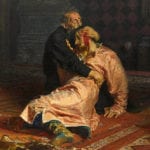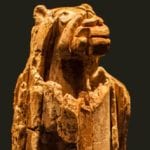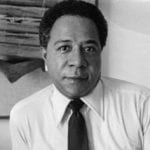 Mysteries
Mysteries  Mysteries
Mysteries  History
History 10 Surprising Stories About the Texas Rangers
 Humans
Humans 10 Philosophers Who Were Driven Mad by Their Own Theories
 Miscellaneous
Miscellaneous 10 Video-Game-Worthy Weapons and Armors from History
 Weird Stuff
Weird Stuff 10 Psychics Who Accurately Predicted Wartime Events
 The Arts
The Arts 10 Pieces of Art Inspired by a Broken Heart
 Health
Health 10 Science Fiction-Sounding New Medical Treatments
 History
History 10 Surprising Facts About the Father of Submarine Warfare
 Space
Space Ten Astonishing New Insights into Alien Worlds
 Weird Stuff
Weird Stuff 10 Bizarre Summer Solstice Rituals Still Practiced Today
 Mysteries
Mysteries Top 10 Haunting Facts About the Ghost Ship MV Alta
 History
History 10 Surprising Stories About the Texas Rangers
 Humans
Humans 10 Philosophers Who Were Driven Mad by Their Own Theories
Who's Behind Listverse?

Jamie Frater
Head Editor
Jamie founded Listverse due to an insatiable desire to share fascinating, obscure, and bizarre facts. He has been a guest speaker on numerous national radio and television stations and is a five time published author.
More About Us Miscellaneous
Miscellaneous 10 Video-Game-Worthy Weapons and Armors from History
 Weird Stuff
Weird Stuff 10 Psychics Who Accurately Predicted Wartime Events
 The Arts
The Arts 10 Pieces of Art Inspired by a Broken Heart
 Health
Health 10 Science Fiction-Sounding New Medical Treatments
 History
History 10 Surprising Facts About the Father of Submarine Warfare
 Space
Space Ten Astonishing New Insights into Alien Worlds
 Weird Stuff
Weird Stuff 10 Bizarre Summer Solstice Rituals Still Practiced Today
20 Great Choral Works From Before 1750
I have sung in classical choirs for more than 25 years. Many of the choirs I have sung in have specialised in “early music”. (The cut-off date for this varies, but I have chosen 1750.) There are many great choral works which I would like to share with you.
I have limited myself to works from western European Christianity, which is where my experience is. I have limited myself to one work per composer. With some tweaking at either end, the list is in chronological order. The information is as brief as I could make it and still be comprehensible, but I hope I have given you enough information to understand the composer and the work.
There is necessarily a large amount of Christian church history, theology and imagery here. If you are not into that, please sit back and enjoy the music. This selection is personal and subjective, but I believe that any list of great works from this era would include many of these works. These are “great works”, not “the greatest works”.
The composer of this music is unknown. The music is either based on, or was the source for, a devotional hymn “Orbis factor, rex aeternae eleison” (“Creator of the world, eternal king, have mercy”). The clip intersperses the song and the liturgical text.
Central to the worship of the Christian Church (then and now) is the Mass, a memorial of the last meal shared by Jesus and his disciples. Typically, five texts are set to special music. The first is the penitential “Kyrie eleison” (“Lord, have mercy), which is in Greek, compared to the Latin used for the other texts.
The performance in the clip is by Ensemble Organum, a group founded in 1982 by Marcel Pérès and based in France. This group specialises in chants that were in use before Gregorian chant (the variety of chant most widely used in the Western Church) developed, or that survived in alongside it.
Hildegard was a Geman abbess, polymath and composer. She is the first composer whose biographical details are known. She lived in convents from an early age, and became probably the most accomplished woman of her time. Founding and administering convents, writing theological, botanical, and medicinal texts, letters (to popes, emperors and saints), liturgical songs, poems and the first surviving morality play. Much of her music was written for religious ceremonial performance by the nuns of her convents. Her music is described as monophonic; that is, consisting of exactly one melodic line, designed for limited instrumental accompaniment and characterised by soaring soprano vocalisations.
Very little about Pérotin is known. He was probably French and active at the Cathedral of Notre Dame, Paris. He pioneered the styles of organum triplum and organum quadruplum (three and four-part polyphony). This work is in three-part polyphony. A prominent feature of his compositional style was to take a simple, well-known melody and stretch it out in time, so that each syllable was tens or even hundreds of seconds long, and then use each note of the melody (the tenor, Latin for “holder”, or cantus firmus, Latin for “firm song”) as the basis for rhythmically complex, interweaving lines above it. The result was that one or more vocal parts sang free, quickly moving lines (“discants”) over the chant below.
I can find no information about the words. I assume that is was sung immediately before the gospel reading during the Mass, and that the words have something to do with the birth of Jesus.
The performance is by the Hilliard Ensemble directed by Paull Hillier, the members of which appear in the clip.
Machaut was a French poet and composer. He held church and royal/noble court appointments in Flanders and France. His poetry was admired and imitated by Geoffrey Chaucer, among others. He composed in a wide range of styles and forms and his output was enormous. His most important work is the Messe de Nostre Dame, the earliest known complete setting of the Mass by a single composer. Unusually for a composer of church music of his times, the vast majority of his works are secular, almost always dealing with courtly love.
The words, which are another major text of Mass, begin “Holy, holy, holy is the Lord God of Hosts”.
The performance in the clip is by the Ensemble Gilles Binchois.
Dufay was a Franco-Flemish priest, music theorist and composer. He travelled widely and held a number of church and royal/noble court appointments in Flanders, France and Italy. He was among the most influential composers of the 15th century, and his music was copied, distributed and sung everywhere that polyphony had taken root. Almost all composers of the succeeding generations absorbed some elements of his style. The wide distribution of his music is all the more impressive considering that he died several decades before the availability of music printing. He wrote in most of the common forms of the day.
The words are from a hymn of devotion to Mary and begin “Hail, star of the sea”.
Ockeghem was a Franco-Flemish singer, choirmaster, teacher and composer. He held a number of church and noble/royal court positions (not only musical but also administrative/diplomatic) in Flanders and France. His most important work is his Missa pro Defunctis which is the earliest surviving polyphonic Requiem mass. Being a renowned bass singer himself, his use of wide-ranging and rhythmically active bass lines sets him apart from many of the other composers of his time.
The words are “Thanks be to God”, said at the very end of the Mass, but not often set to music. This setting has 36 individual lines of music, divided into 4 choirs of 9 lines each. This is astonishingly complex music for the time.
The performance is by the Huelgas Ensemble directed by Paul van Nevel.
Josquin was a Franco-Flemish composer. Writers as diverse as Baldassare Castiglione and Martin Luther wrote about his reputation and fame. The newly-developed technology of printing made wide dissemination of his music possible. Despite his colossal reputation, we know very little about his life. He wrote in all the significant vocal forms of his time. He liked to solve compositional problems in different ways in different compositions. Sometimes he wrote in an austere style devoid of ornamentation, and at other times he wrote music requiring considerable virtuosity. He travelled widely and held various church and royal/noble court appointments.
This work does not set the biblical “Ave Maria” text, but rather a devotional poem to Mary.
Taverner was an English organist and composer, and is widely regarded as the most important English composer of the pre-reformation era. He was appointed by Cardinal Wolsey as the first organist and master of the choristers at Cardinal College, Oxford (later renamed Christ Church). He was reprimanded for (probably minor) involvement with Lutherans, but escaped punishment for being “but a musician”. Wolsey later fell from favour and Taverner left the college. His most important works are the Western Wynd Mass, based on a popular song by that name, and the Missa Gloria tibi Trinitas, based on a plainchant. The 20th century composer Sir John Tavener is a direct descendant.
The words, from the Mass, are “Holy, holy, holy is the Lord God of Hosts”, which is the first part of the text used in item 4.
Tallis was an English organist and composer. His life spanned the English reformation. He held various church music positions, and was a Gentleman of the Chapel Royal under Henry VIII, Edward VI, Mary and Elizabeth I. Throughout his service to successive monarchs, Tallis avoided the religious controversies that raged around him. His best known works are the nine psalm chant tunes for four voices he wrote for Archbishop Parker’s Psalter in 1567, his settings of the Lamentations of Jeremiah the Prophet and Spem in alium written for eight five-voice choirs, possibly for Elizabeth’s 40th birthday in 1573. In 1575 Elizabeth Tallis and his younger contemporary William Byrd a patent to print and publish music, which was one of the first arrangements of that type in the country.
The text is a paraphrase of Acts 2 and begins “The apostles began to speak in other tongues (or languages)”. Tallis’s music is interspersed with plainchant, and the plainchant is also hidden deep within the polyphonic sections.
Three for the price of one. The best clip of this work has another, unrelated, piece before it. Loquebantur starts at 2.29. At 6.05 is Tallis’s best-known shorter work (in English) “If ye love me”. The performers are the Tallis Scholars directed by Peter Philips.
Palestrina was an Italian composer. His work can be seen as a summation of Renaissance polyphony. He held a number of church positions in and around Rome. He wrote sacred music almost exclusively. His masses and motets are in the repertoire of every choir of this type.
The Missa Papae Marcelli (Mass for Pope Marcellus) was supposedly written to persuade the Council of Trent that a ban on polyphonic treatment of text in sacred music was unnecessary. More recent scholarship has shown that this mass was composed before the cardinals convened to discuss the ban (possibly as much as ten years before). It is probable, however, that Palestrina was quite conscious of the needs of intelligible text in conformity with the doctrine of the Counter-Reformation, and wrote his works towards this end from the 1560s until the end of his life.
The words make up the last major text of the Mass, and begin “Lamb of God, that takes away the sins of the world, have mercy on us”.
Parsons was an English composer, about whom little is known. He was an assistant to the Master of the Children Choristers of the Chapel Royal, then a Gentleman of the chapel. He composed a small number of sacred and secular vocal compositions, of which this is by far the most well-known. He is believed to have died in January 1572 when he fell into the then swollen River Trent and drowned.
The words are from Luke 1.28, 42 and begin “Hail, Mary, full of grace”.
The performance is by the Cambridge Singers directed by John Rutter.
Byrd was an English composer. He held a number of church appointments, particularly as a Gentleman of the Chapel Royal. In 1572 he and Thomas Tallis were granted a joint printing licence from Queen Elizabeth. Despite his Roman Catholic sympathies, he worked in the court of the Elizabeth I. With equal skill he composed music in Latin for the Roman liturgy (possibly the finest by any English composer) and in English for the Anglican liturgy. He also wrote secular songs, madrigals and keyboard pieces.
Sing joyfully is a motet in English. The words are from Psalm 81 and begin “Sing joyfully unto God our strength”. This work shows that, in contrast to the simplicity of Tallis’s If ye love me (No 9), settings in English could be and often were quite complex.
The performance in the clip is by the choir of Winchester Cathedral, probably directed by David Hill.
Victoria was a Spanish priest and composer. He held church and court positions in Spain and Italy. His standing is often compared to Palestrina. Many commentators hear in Victoria’s music a mystical intensity and direct emotional appeal, qualities considered by some to be lacking in the arguably more rhythmically and harmonically placid music of Palestrina. His melodic writing and use of dissonance is more free than that of Palestrina.
Tenebrae is a series of three devotional services held late in the evenings of the Wednesday, Thursday and Friday of Holy Week. A special feature is the use of a row of candles, which are extinguished one by one after each item, ending the service in darkness. The words are from Luke 23 and begin “Darkness covered the land”.
The performance in the clip is by the English choir The Sixteen, directed by Harry Christophers.
Giovanni Gabrieli was an Italian organist and composer. His major appointment was as principal organist and composer at St Mark’s Basilica, Venice. Like composers before and after him, he used the unusual layout of the St Mark’s, with its two choir lofts facing each other, to create striking spatial effects. Most of his pieces are written so that a choir or instrumental group will first be heard from the left, followed by a response from the musicians to the right. Gabrieli perfected this technique in works such as In Ecclesiis, a showcase of polychoral techniques, making use of four separate groups of instrumentalists and singers.
The words are from Ps 47 and begin “Clap your hands, all the earth”.
The performance in the clip is by the Gabrieli Consort and Players, directed by Paul McCreesh.
Monteverdi was an Italian singer, viola da gambist, composer and, late in his life, priest. His life and musical output spans the end of the Renaissance and the beginning of the Baroque period of musical history. He held positions in Mantua and Venice. He wrote madrigals, church music and operas. His opera L’Orfeo (Orpheus) is probably the earliest opera still regularly performed.
Vespers was a daily service held in the late afternoon. It featured five psalms, motets or instrumental pieces and the Magnificat (Luke 1). Monteverdi’s setting is on a monumental scale, and there has been some controversy as to whether all the movements were intended to be performed in a single service. The service opens with verses from Ps 70 “O God, come to my assistance”. Monteverdi re-uses music he had composed for “L’Orfeo”.
The information attached the youtube clip specifically mentions the conductor Gabriel Garrido, but the rest of the information is confusing. He is most closely associated with the Ensemble Elyma. His recording of this work includes that ensemble, plus the Studio di Musica Antica Antonio il Verso, Coro polifónico GP da Palestrina and Les Rossignols de Poznan, so they may be the performers on the clip.
Tomkins was a Welsh composer who lived most of his life in England. He held appointments at Worcester Cathedral and the Chapel Royal. He wrote madrigals, keyboard music, consort music, anthems, and liturgical music. Stylistically he was extremely conservative, even anachronistic: he seems to have completely ignored the rising Baroque practice around him, with its Italian-inspired idioms, and he also avoided writing in most of the popular forms of the time, such as the lute song, or ayre. His polyphonic language was that of the Renaissance.
The text is from 2 Samuel 18 and tells of the grief of King David after the death of his favourite son Absalom, who had rebelled against him. (Warning: the compiler of the clip switches from biblical imagery to modern-day photos of parental grief, which may be disturbing.)
(How to start an argument between two singers of early choral music: Ask “Which is better – Tomkins or Weelkes?” I say Weelkes, but couldn’t find a clip of that on youtube.)
Purcell was an English keyboardist and composer. He became organist at Westminster Abbey at the age of 22 when one of his teachers, John Blow, stood aside from that position in his favour. (Blow took over again after Purcell’s early death). Later, he also held the position of organist of the Chapel Royal. He wrote music for both the church and the theatre. Famous works include “Dido and Aeneas”, one of the first operas in English, “I was glad” and “My heart is inditing”, written for the coronation of King James II, and the funeral music for Queen Mary, which was also performed at his own funeral soon after. This work was written around 1680 and is believed to be the first section of a longer complete work. It is, in my humble opinion, the most perfect 2 minutes of music ever written.
The words are from Psalm 102 verse 1.
The performance is by the Choir of Clare College Cambridge directed by Timothy Brown. Unlike the better-known English cathedral and college choirs, this one uses (young) adult women for the soprano and alto lines.
Vivaldi was a Italian priest, virtuoso violinist, teacher and composer. His major musical appointment was at the Pio Ospedale della Pietà, one of four orphanages in Venice financed by the Venetian government. Boys learned a trade and had to leave at age 15, while girls received a musical education and the most talented stayed and became members of the Ospedale’s renowned orchestra and choir. Vivaldi wrote most of his concertos, cantatas, and sacred music for them. He also had considerable success as an opera impresario and composer. His most famous work is the set of four violin concertos, the Four Seasons.
The Gloria is a text from the Mass, and begins “Glory to God in the highest, and peace to his people on earth”. It is usually set to music along with the four other principal texts of the Mass, but sometimes as a stand-alone peice. Vivaldi’s famous setting of the text sets every sentence as a separate movement. The famous opening movement “Glory to God in the highest” is followed by the supremely beautiful “and peace to his people on earth”.
The performance in the clip is by the Kaohsiung Chamber Choir and an un-named orchestra from southern Taiwan. I chose this performance to show just how far this music has travelled. (The soloists sitting at the front sing in other movements.)
Bach was a German organist, composer and teacher. He held church and court positions in Germany. Although he did not travel far, he was aware of musical developments elsewhere. His output is astonishing in its quanity and quality: the Well-Tempered Clavier, the Goldberg Variations and suites and partitas for harpsicord; several hundred works for organ; sonatas and partitas for solo violin; suites for cello; the Brandenburg concertos and suites for orchestra; the Mass in B Minor, the St Matthew Passion, the St John Passion and several hundred other works for choir. Despite this, his music was not widely known, and was considered “old-fashioned” by those who did know of it, especially late in his career when the musical fashion tended towards rococo and classical styles. A revival of interest in and performances of his music began early in the 19th century, and he is now widely considered to be one of the greatest composers in the Western tradition.
What work to pick to represent Bach? I chose this for sentimental reasons: it was part of the first choral/orchestral concert I ever sang in. A cantata is a musical meditation on the bible readings for the day, using arias and choruses, very often incorporating a hymn appropriate to the theme. This cantata “Sleepers, wake! a voice is calling” meditates on Matthew 25. The opening chorus has the sopranos singing the unadorned hymn tune, with the other choir parts and orchestra providing the contrapuntal underlay.
The performance in the clip is by the Amsterdam Baroque Orchestra and Choir directed by Ton Koopman. Watch for the instruments reproducing those used in Bach’s time. (Possibly some of them are from Bach’s time.)
Handel was a German-born, naturalised English keyboardist and composer. He benefited from patronage by royals and nobles, but held no formal court (or church) appointments. He made his living as a concert performer and entrepreneur of firstly opera, then oratorio. His most famous works are the oratorio Messiah, and the orchestral works Water Music and Music for the Royal Fireworks.
An oratorio is a extended work that tells a biblical or historical story through recitatives, arias and choruses. They originally developed as extra devotions for churchgoers, but became generally popular (and lucrative) when opera theatres were forced to close during the penitential season of Lent (approx Feb-Mar), but were allowed to present religiously-themed oratorios. Messiah tells the story of Jesus in words from the King James Version English translation of the Bible.
The performance in the clip is by a number of student and amateur choirs and orchestras from France and Germany, directed by Daniel Colombat. I chose this performance for its sheer exhuberance and to show that this music is not the exclusive preserve of specialist groups. This has got everything: electronic keyboards, bass clarinets, choristers sharing scores and trumpeters fluffing notes.
Notable omissions: so many! This barely scratches the surface.
This article is licensed under the GFDL because it contains quotations from Wikipedia.








